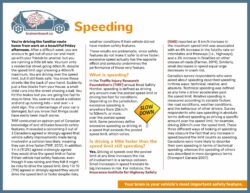Speeding
You’re driving the familiar route home from work on a beautiful Friday afternoon. After a difficult week, you are anxious to get out of your car and meet up with your friends to unwind, but you are running a little bit late. You turn onto a residential street going 60km/h, despite the speed limit sign showing a 40km/h maximum. You are driving over the speed limit, but it still feels safe. You know these streets like the back of your hand. Suddenly, just a few blocks from your house, a small child runs into the street chasing a ball. You hit the brakes but you are going too fast to stop in time. You swerve to avoid a collision and end up running into – and over – a yield sign. The undercarriage of your car is damaged, but you know that things could have easily been much worse.
TIRF conducted an opinion poll of Canadian knowledge of and attitudes towards safety features. It revealed a concerning 2 out of 3 Canadians agreed or strongly agreed that vehicle safety improvements made being involved in a collision less likely, meaning they can drive faster (TIRF, 2012). In addition, 1 in 6 (17.2%) agreed orstrongly agreed they would drive the speed limit or faster if their vehicle had safety features, even though it was raining and they felt it might be risky to drive the speed limit. Only 1 in 10 (11%) agreed or strongly agreed they would drive the speed limit or faster despite risky weather conditions if their vehicle did not have modern safety features.
These results are problematic, since safety features do not make it safer to drive faster; excessive speed actually has the opposite effect and seriously undermines the performance of those very feature.
What is speeding?

Is driving a little faster than the speed limit still speeding?
Yes. Driving at speeds over the posted limit at any time increases the risk of involvement in a serious collision. Small increases in speed translate to big increases in risk. For instance, the Insurance Institute for Highway Safety (IIHS) reported an 8 km/h increase in the maximum speed limit was associated with an 8% increase in the fatality rate on interstates and freeways (i.e., highways), and a 3% increase in fatalities on other classes of roads (Farmer, 2019). Similarly, small decreases in speed equal large decreases in crash risk.
Canadian survey respondents who were asked about speeding described speeding in three ways: technical, relative, and absolute. Technical speeding was defined as any time a driver accelerates past the speed limit. Relative speeding is measured according to variable factors like road conditions, weather conditions, and the behaviour of other drivers. Survey respondents who saw speeding in absolute terms defined speeding as driving a specific amount over the speed limit, for example, driving 20km/h over the speed limit. These three different ways of looking at speeding may obscure the fact that any increase in speed beyond the limit counts as speeding. Canadians were more likely to describe their own speeding in terms of technical speeding, whereas the speeding of others was described in more dangerous terms (Transport Canada 2007).
How does speeding affect traffic safety?
Excessive speed is a common cause of crashes on Canadian roads. Every year, more than 400 Canadians die in collisions where speed was a major contributing factor (TIRF, 2020). In Canada, speed is a contributing factor in up to 18% of crashes leading to serious injury or death. Overall, it is estimated that more than 1 in 4 (25%) of fatal collisions involve speed as a contributing factor (TIRF, 2024).
Speed not only affects crash risk, but it is also directly related to crash severity. Driving at a faster rate of speed increases the total amount of kinetic energy, which in turn increases the risk of severe injury in a collision. In addition, faster speeds make it more likely the safety thresholds of the vehicle and safety devices will be exceeded in the event of a crash. This erodes the protection available to vehicle passengers.
Are Canadians concerned about speeding?
Yes. Canadians seem to recognize the dangers of driving at excessive speeds. When asked about their views on speeding and road safety, 68% of Canadians surveyed said that excessive speeding was a serious or very serious problem (TIRF, 2007). A little more than half of Canadians surveyed (52%) agreed people are speeding excessively more today than five years ago, and 81% of respondents said excessive speeding is likely to cause a crash. These attitudes towards speeding are consistent with research about the effects of speeding on crash risk.
What are the laws on speeding?
Exceeding the speed limit at any time is illegal and carries the possibility of a penalty. The severity of the penalty increases with the number of km/h over the speed limit when you were caught. In Ontario, types of punishments for speeding include a combination of demerit points, fines, insurance repercussions, and sometimes licence suspensions. Recent campaigns against street racing and stunt driving have spurred the implementation of the most severe speeding infractions; street racers face six demerit points, up to $10,000 in fines, immediate vehicle impoundment, licence suspension, a jail term up to six months and a mandatory driver improvement course, upon conviction. However, any driver caught exceeding the speed limit will potentially face punitive action. For example, driving 20 km/h over the speed limit in Ontario – a speed considered on the low end of speeding according to absolute definitions – brings with it three demerit points, a $90 fine, and usually increased insurance rates for several years.
How many drivers speed?
Despite the fact Canadians seem to be aware both of the illegality of speeding and the dangers it presents, a large majority of road users often see other drivers exceeding the speed limit. A large majority of drivers (91%) reported seeing other drivers speeding (TIRF, 2023). This finding is consistent with previous polls, which report that speeding continues to be the more frequently observed aggressive driving behaviour (TIRF, 2007).
The number of survey respondents who admit to speeding may vary across different studies because of how particular individuals define speeding. For example, if someone does not consider technical speeding to really be speeding, then they are less likely to report they speed frequently, even if they do. Among Canadian respondents in the 2023 ESRA (E-Survey of Road Users’ Attitudes), 60.1% of Canadian respondents admitted to speeding on highways; 57.6% admitted to speeding on two-lane highways and country roads; and 53% admitted to speeding in built-up areas. In addition, 30.5% admitted to driving too fast for conditions at the time which included poor visibility, dense traffic, presence of vulnerable road users (ESRA, 2024).
Who is most likely to speed?
Speeding is not isolated to any particular demographic. However, there are certain characteristics common among chronic, excessive speeders:
- Frequent speeders tend to be in the youngest age group (16-24 years) (TIRF, 2007).
- Frequent speeders are more likely to be male (TIRF, 2007).
- Drivers who speed frequently drive more kilometres per month than people who do not speed (TIRF, 2007).
- Frequent speeders are likely to feel confident they can maintain control of their vehicle: 32.3% of Canadians who admitted to speeding frequently said they were confident that they were still in control despite excessive speed, and 44.7% said they were very confident (TIRF, 2007).
- All this despite the fact that 895,200 drivers who were speeding reported having to brake or steer to avoid a collision in the past month, the majority having to do so on multiple occasions (TIRF, 2007).
- The largest percentage of fatally injured drivers involved in speed-related collisions were drivers aged 16 to 19 (47.5%) as well as those aged 20 to 24 (45.2%) and 25 to 34 (42.1%) (TIRF National Fatality Database, 2024).
- While 30% of all fatally injured drivers had been drinking during the past five years, almost half (48%) of speeding drivers had been drinking (TIRF, 2024).
What effect does speed have on safety features?
Despite the advanced engineering that goes into the development and production of current safety technology, speeding can have a considerable negative effect on the performance of vehicle safety features. In particular, excessive speed limits your ability to interact appropriately with your vehicle safety features by reducing the amount of time you have to react to potential hazards on the road.
Vehicle safety features depend heavily on you to provide the right kind of steering and braking input before and during their activation. The faster you are going, the less likely you will be able to brake and steer safely, even with advanced safety features on your vehicle. Noticing a hazard that requires emergency braking two seconds before a collision gives you enough time to hit the brakes and activate emergency brake assist technology to help you stop if you are travelling at 50 km/h. However, at 65km/h, you can expect a collision (NHTSA, 2007). You have a very important role to play in making your safety features work best. Speeding makes fulfilling this role much more difficult, and, in some cases, impossible.
What kinds of safety features are affected by speeding?
In addition to making it more difficult for you to properly use your safety features, excessive speed can make it impossible for safety features to perform to the level for which they were designed. This is because safety technologies have both design and functional limitations that can be breached once you pass certain speed thresholds. For example, safety features like brake assist, ABS, and electronic brake-force distribution promise to help you brake more safely. However, speeding can make safe braking nearly impossible if an unexpected hazard presents itself. In this case, even if the braking technology works as it should, excessive speed may make a safe outcome extremely unlikely. Similarly, safety features like electronic stability control – one of the most effective new safety features – may not be able to stabilize a car and, travelling at an excessive speed that is forced to swerve. No safety feature is immune to the negative consequences of speeding.
Finally, excessive speed can easily be the final factor determining whether you are in a serious crash when combined with other vehicle safety issues like poor vehicle maintenance. For example, the performance of your ABS setup is dependent in part on the condition of your brakes and tires. Tires and brakes that are worn down will undermine the functionality of ABS and prevent it from working as well as it should.
If you are travelling at a safe speed, you may still be able to get some small benefit from having ABS, despite the neglected state of the tires and brakes. However, excessive speed coupled with poorly maintained vehicle parts dramatically increases your risk of being involved in a collision that your vehicle safety technology would have otherwise prevented.
Where can I find more information about speeding?
Every year, TIRF publishes the Road Safety Monitor (RSM), a survey designed to gauge public opinion on a range of key road safety issues. In 2021, TIRF released an RSM including a section on excessive speeding. Many of the facts, statistics, and research in this document are pulled from the RSM on excessive speeding. You can access this RSM, previous reports, and other TIRF publications on this website or by visiting the TIRF website at www.tirf.ca.
In addition, Transport Canada has conducted extensive research on speeding and Canadian attitudes towards excessive speed and countermeasures. A qualitative and quantitative study on driver attitudes to speeding and speed management was conducted by Transport Canada in 2007, from which facts and figures have also been pulled to inform this document. You can access this study and other publications concerning speed and road safety published by Transport Canada by visiting their website at www.tc.gc.ca.
Visit brainonboard.ca/program-resources/references for a full list of references.
Related Videos
Play Video



